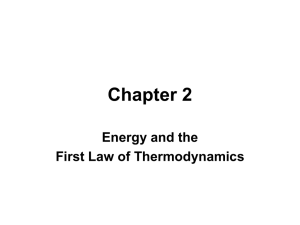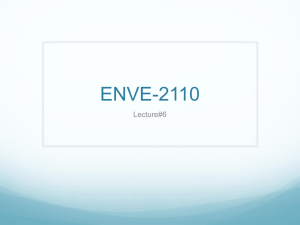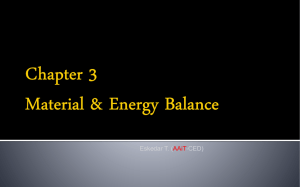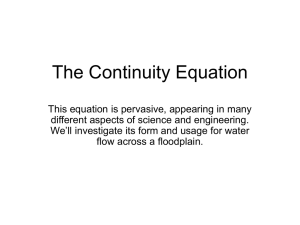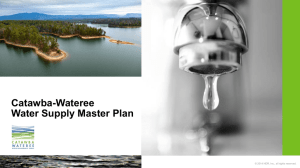Power Point Slides 1
advertisement
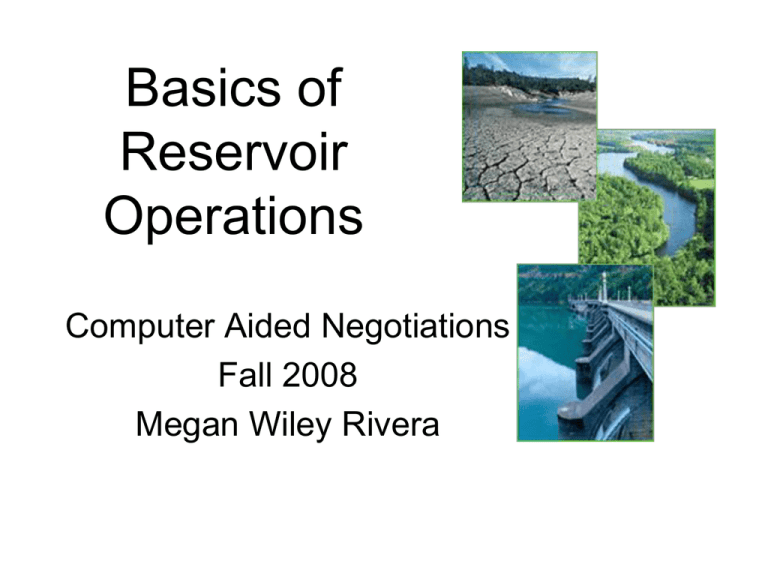
Basics of Reservoir Operations Computer Aided Negotiations Fall 2008 Megan Wiley Rivera 0:10 1:45 Watershed water balance 2:40 Water Budgets—Conservation of Mass • Mass is not created or destroyed • What goes in – what comes out = change in what’s inside 3:30 Apply conservation of mass to an atm interaction • • • • Starting balance: $2000 Deposit a check for $50 Take out $30 Ending balance: $2020 $50 $30 ATM $2000 in account What goes in – what comes out = change in what’s inside (final balance – initial balance) $50 – $30 = $2020 - $2000 4:05 A dollar is easier to track than a unit of water • Water is “incompressible” • a unit volume of water is not created or destroyed • Must define boundaries to apply equation (control volume) 5:15 Time must be considered as well • Often times, inflows and outflows are measured as flow rates • The change in storage must therefore also be specified over some length of time 6:20 Try it for a Britta Filter • How long can you leave your Britta pitcher filling in the sink before it starts overflowing? 6:50 Draw a Control Volume 7:00 Some Numbers • Inflow, Qin = 2.5 gpm • Outflow, Qout = 1 gpm (note, this is a cheat. The outflow flow rate increases as the chamber fills) • Chamber dimensions: 8” tall, 24 in2 cross sectional area • 1 cubic in = 0.00433 gals 8:40 The Equation • What goes in – what comes out = change in what’s inside • Qin – Qout = dV/dt • Work with a partner to figure it out Feel free to ask someone else if you get stuck (there are different approaches) • Inflow, Qin = 2.5 gpm • Outflow, Qout = 1 gpm (note, this is a cheat. The outflow flow rate increases as the chamber fills) • Chamber dimensions: 8” tall, 24 in2 cross sectional area • 1 cubic in = 0.00433 gals Qin – Qout = dV/dt 12:30 The Answer • Initial volume = 0 • Final volume = 24 in2 * 8” = 192 in3 • Convert to gallons: 192 in3 * (0.00433 gal/1 in3) = 0.83 gal • Apply equation: 2.5 gpm – 1 gpm = 0.83 gal/x min • Solve equation: x min = 0.83 gal/(1.5 gpm) = 0.55 min or about 30 second 13:00 Now Let’s Apply It to a Reservoir town dam lake Draw Control Volume and Specify Inflows and Outflows 14:50 Draw Control Volume and Specify Inflows and Outflows evaporation precipitation Effluent (returns) Water supply diversions (demands) Dam release Groundwater exchange runoff 16:15 An Aside: Identifying Consumptive Uses (water removed from the basin) evaporation evaporation irrigation Groundwater exchange runoff infiltration An Aside: Identifying Consumptive Uses (water removed from the basin) evaporation Effluent (returns) Water supply diversions (demands) Other consumptive runoff uses (e.g. manufacturing) 24:45 Back to Conservation of Mass Net demands, D Net Evapotransporation, ET evaporation precipitation Effluent (returns) Water supply diversions (demands) Dam release Groundwater exchange Qout Unimpaired inflow, I runoff 25:35 What Is Unimpaired Inflow? 26:25 Why Might We Want to Calculate It • If you want to model different operational scenarios, you need to know how much water is reaching the river via runoff (as opposed to upstream operations) • Also gives information about flow in the river without the presence of reservoirs (possible point of comparison) 32:20 Use the equation to calculate unimpaired inflows (daily average) Net demands, D Net Evapotransporation, ET evaporation precipitation Effluent (returns) Water supply diversions (demands) Dam release Groundwater exchange Qout Unimpaired inflow, I runoff Use the equation to calculate unimpaired inflows (daily average) Measured/modeled/estimated from meteorological info measured Net Evapotransporation, ET Net demands, D Qout measured Unimpaired inflow, I measured Beginning and end of day stages 32:30 Storage-Area-Elevation Table Surface area elevation Storage = volume of water Mean sea level Storage (af) Area (acres) Elevation (ft) 0 5.8 32 1181 378 43 9930 1780 53 11957 2272 54 34055 4978 60 32:40 Use the equation to calculate unimpaired inflows (daily average) Net Evapotransporation, ET Net demands, D Qout Unimpaired inflow, I • • • • • Beginning and end of day stages What goes in – what comes out = change in what’s inside Qin – Qout = dV/dt, or over the day: Qin,daily ave – Qout, daily ave = Storageend of day – Storagebeginning of day I – ET – Qout – D =Work Storage end ofpartner day – Storage beginning of day with your again I = ET + Qout + D + Storageend of day – Storagebeginning of day 35:20 Use the equation to calculate unimpaired inflows (daily average) Net Evapotransporation, ET Net demands, D Qout Unimpaired inflow, I • • • • • Beginning and end of day stages What goes in – what comes out = change in what’s inside Qin – Qout = dV/dt, or over the day: Qin,daily ave – Qout, daily ave = Storageend of day – Storagebeginning of day I – ET – Qout – D = Storageend of day – Storagebeginning of day I = ET + Qout + D + Storageend of day – Storagebeginning of day Fun with units Net Evapotransporation, ET Net demands, D Qout Unimpaired inflow, I Beginning and end of day stages • I = ET + Qout + D + Storageend of day – Storagebeginning of day 0.3” 50 mgd 100 cfs Stage = 54’ Do calculations first in af/day and then mgd Stage = 53’ 39:30 Storage (af) Area (acres) Elevation (ft) 0 5.8 32 1181 378 43 9930 1780 53 11957 2272 54 34055 4978 60 Net Evapotransporation, ET Net demands, D Qout Unimpaired inflow, I Beginning and end of day stages • I = ET + Qout + D + Storageend of day – Storagebeginning of day 0.3” 50 mgd 100 cfs Stage = 54’ Do calculations first in af/day and then mgd Stage = 53’ • I = ET + Qout + D + Storageend of day – Storagebeginning of day 0.3” 50 mgd 100 cfs Stage = 54’ Stage = 53’ ET: Multiply by average surface area for the day (see SAE) = 2026 acres 0.3” * 2026 acres = 0.025’ * 2026 acres = 50.7 af in one day Outflow: 100 cfs * 1.98 af/day / 1cfs = 198 af/day Demands: 50 mgd * 1 af/day / 3.069 mgd = 16 af/day I = 50.7 af/day + 198 af/day + 16 af/day + (11957 af – 9930 af)/day = 2292 af/day This is 747 mgd

